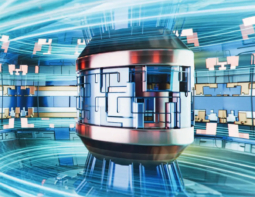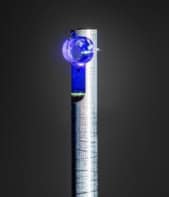Novel techniques for the production and deposition of nanoparticles have some exciting medical applications, according to Alistair Kean and Lars Allers

Plasma-enhanced sputtering and nanoparticle deposition are among the new physical techniques that allow the generation and controlled deposition of materials such as silver, silicon carbide and tantalum. These materials are of great interest to medical-device scientists because they can be used to create biocompatible coatings for medical implants. Such coatings reduce the chance that an implanted device will be rejected by the patient’s immune system or cause infection, and they will surely play a leading role in the evolution of medical-device science in the near future.
Mantis Deposition has developed a novel technique that allows the generation and deposition of nanoparticles in vacuum via magnetron sputtering under relatively high pressures. Unlike normal thin-film vacuum-deposition techniques, such as electron-beam evaporation or sputtering, our nanoparticle method provides control over the density and porosity of the coating. In addition, no heat is generated at the substrate, so the most delicate of materials, including organic molecules, can be coated. Finally, almost all other techniques for producing nanoparticles create a powdered material that has to be purified or refined further before being used for a coating, whereas our technique enables the direct generation, characterization and energy-controlled deposition of the nanoparticles to form a nanostructured coating in a single process. This has allowed us to produce revolutionary new materials and coatings.
The company is taking part in several European Union- and UK-funded research projects in the areas of antibacterial coatings, photocatalytic materials, fuel cells and biosensors. At the moment, for example, we are completing a project funded by the Department of Trade and Industry (now the Technology Strategy Board) that aims to develop a prototype system for creating antibacterial coatings. In the first instance, this will be used for cleaning medical instruments. These are usually sterilized in an autoclave — a pressurized device designed to heat aqueous solutions above their boiling point — but it has recently been noted that certain prions (protein-based infectious particles) can withstand the autoclave process. In contrast, our system first cleans the surface in vacuum using a radio-frequency plasma, which removes all contamination, and then applies a coating of silver nanoparticles that have been accelerated electrostatically.
Silver is known to have antibacterial properties, so this generates an active antibacterial coating. The accelerated nanoparticles also form an extremely adherent coating without the need for any binders or additives. This technology could also be used to make nanoparticle markers for use in magnetic resonance imaging, to coat medical implants, to make biosensors and, indeed, any application where careful control of the surface structure and stoichiometry could improve the functionality of a product.
Vacuum-deposition technology must overcome several challenges, however, if it is to be used to produce medical devices. Health and safety are of utmost importance, and regulations influence the materials that can be used as well as how they are produced. Factors such as adhesion of the coating are critical where the device is to be implanted because any bits of coating that come off can be harmful to the patient. With our nanoparticle technology it is possible to control the adhesion of layers by applying electrostatic acceleration to the charged nanoparticles. It is also import-ant that coated surfaces are very clean, and in vacuum it is possible to employ any of several techniques for surface preparation, including plasma cleaning and heating. Finally, the successful technique must be both technically and economically scalable.
These advantages mean that vacuum-deposition techniques are finding unique roles to play in the production of medical devices, in many cases where chemical techniques have failed to produce materials and coatings of sufficient quality. The new physical nanoparticle techniques are producing materials that have demonstrated more than significant increases in the performance of certain medical devices during clinical tests. Mantis owns intellectual property that addresses the issues of process efficiency and scaling-up, and we envisage that this technology will be used in a commercial product within two years.



